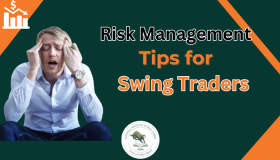25 Jul 2024
Risk Management Tips for Swing Traders

Swing trading is a very popular strategy among stock market enthusiasts. In this strategy, a trader holds a position for several days or weeks to capitalise on short-term price movements.
Swing trading presents opportunities for traders who like to benefit from market volatility without needing constant monitoring. However, to achieve success in swing trading, risk management is necessary. Since markets are dynamic and unpredictable, traders are usually exposed to many risks, so practical risk management tips are essential.
At NIWS, we aim to educate our students and traders about the stock market, its volatile nature, and how to manage its associated risks. We offer various stock market courses in Jaipur, Delhi and Indore to address different aspects of the financial market. In this blog, we wish to educate our readers about risk management tips helpful for swing traders.
Risk in Swing Trading
Swing trading presents an opportunity for traders to gain profits but also carries risks that traders must understand. Below, we explore the different types of risks in swing trading.
1. Market Risk
This is also known as systematic risks. It refers to the different possibilities of losses due to factors that affect the overall performance of the financial market. These could include risks like any political event or economic downfall.
2. Liquidity Risk
When a trader cannot buy or sell stocks without significantly affecting their price, this is known as liquidity risk.
3. Overnight Risk
Certain factors are outside the trader's control when a trader holds on to a position for a day or two. Any event or issue, such as economic data releases or earnings reports published after the markets close, can significantly affect the prices of the shares.
4. Volatility Risk
Volatility risk refers to the potential for any significant price fluctuations in a short period. While volatility can create trading opportunities, it also increases the risk of substantial losses. Traders must know the volatility associated with the stocks they have purchased.
Risk Management Strategies for Swing Trading
Let's discuss some of the most prevalent risk management strategies to ensure your swing trades book profits, not losses.
1. Position Sizing
Position sizing refers to the size of a position within a particular portfolio or the amount an investor will trade. This helps traders determine the quantity of security they can purchase, which further helps them to control risk and maximise returns.
Some of the most commonly used methods to determine position size include-
- Fixed dollar Amount
- Risk per trade
- Percentage of Account Equity
2. Stop-Loss Orders
This is a buy or sell order placed by traders to limit their losses. It is usually done when there is a concern that the prices of the shares may change against the trade.
There are two types of Stop-Loss orders:
- SL order (Stop-Loss Limit) = Price + Trigger Price.
- SL-M order (Stop-Loss Market) = Only Trigger Price.
How do we set effective stop-loss levels?
This can be done through different ways-
- Technical analysis: Using indicators such as resistance levels and trendlines to identify the points for stop loss, a stop loss order is usually placed slightly below the support levels.
- Percentage Method: This requires setting stop-loss orders based on a fixed stock price percentage.
3. Diversification
This involves spreading or investing across different assets, sectors, and categories. It is usually done to mitigate risks and avoid losses beyond recovery. This helps traders build a portfolio that provides more stable performance over time.
Some of the strategies for diversification can include-
- Asset class diversification - Investing in different kinds of assets.
- Sector diversification - Investing in assets from different sectors.
- Geographical Diversification - Invest in geographical regions to spread risk across various markets and economies.
4. Technical Analysis for Risk Management
This involves using previous price data and technical indicators before trading. This can help investors make an informed decision. By properly analysing price data, a trader can identify patterns and recognise the potential entry and exit time from the market.
Some of the critical indicators to consider while conducting technical analysis include-
- Moving Averages- This helps identify trends, resistance, and support levels.
- Relative Strength Index (RSI) - This helps to identify the speed and change of price movements.
- Moving Average Convergence Divergence (MACD) - is a trend-following momentum indicator that shows the relationship between two moving averages of a security’s price.
Other Tips to Reduce the Risk During Risk Trading
Some of the other ways to reduce the risks for swing traders include-
1. Manage Emotions
Keep your emotions aside. Financial trades cannot be conducted with emotional bias, so it is essential to maintain emotional discipline.
2. Avoiding Overtrading
Overtrading refers to the excess buying or selling of securities within a short period. A desire for quick profit can undermine a trader’s long-term success. Overtrading can be avoided by -
- Developing a clear plan and sticking to it.
- Setting realistic goals.
- Limit the number of trades.
- Maintaining a trading journal.
3. Setting Realistic Expectations
Trades can only be done correctly if proper data does not support them. So, ensuring that your goals as a trader align with the trade data is essential. Setting expectations and achievable goals can help you maintain discipline and focus.
Conclusion
Swing trading presents opportunities for traders that they cannot resist. So, you must have the risk management skills and strategies to help you as a swing trader. These strategies can help you gain good trading experience and profits. You can develop a swing trading strategy that aligns with your risk tolerance and financial goals by equipping yourself with technical analysis skills, risk management techniques, and emotional control.
You can also connect with NIWS and learn how stock trades work. Our professionals are industry experts who aim to educate students about the different aspects of the financial market.
